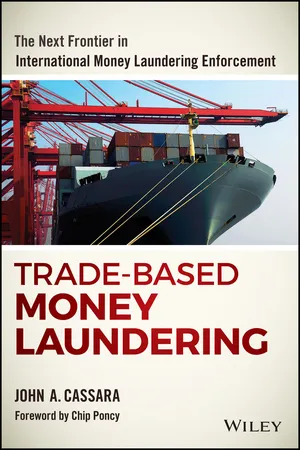
Trade-Based Money Laundering
The Next Frontier in International Money Laundering Enforcement
- English
- ePUB (mobile friendly)
- Available on iOS & Android
Trade-Based Money Laundering
The Next Frontier in International Money Laundering Enforcement
About this book
Uncover the financial fraud that funds terrorist organizations
Trade-Based Money Laundering is an authoritative examination of this burgeoning phenomenon, now coming under scrutiny in the War on Terror. This book walks you through the signs and patterns of trade-based money laundering (TBML) to help you recognize it when it occurs, and shows you how data and analytics can be used to detect it. You'll learn the common value transfer techniques including invoice fraud, over-and-under invoicing, and misrepresentation, and learn why analytic detection systems have yet to be implemented despite the existence of copious data. Case studies from around the world highlight the real-life implications of the concepts and processes presented in the text, giving you a first-hand view of the mechanisms at work inside this expanding illegal market.
Trade-based money laundering uses trade to convert large quantities of illicit cash into less conspicuous assets or commodities to evade financial transparency laws and regulations. As an ideal funding mechanism for terrorist groups, the practice is getting more attention even as it increases in scale and spread. This book takes you deep inside TBML to better arm you against its occurrence.
- Learn the typical value transfer techniques of TBML
- Examine case studies detailing international examples
- Discover why institutions have failed to implement detection systems
- Explore ways in which analytics can identify TBML
According to the U.S. State Department, TBML has reached staggering proportions in recent years, and is considered by many to be the next frontier of international money laundering enforcement. Trade-Based Money Laundering gives you a battle plan, with expert insight and real-world guidance.
Frequently asked questions
- Essential is ideal for learners and professionals who enjoy exploring a wide range of subjects. Access the Essential Library with 800,000+ trusted titles and best-sellers across business, personal growth, and the humanities. Includes unlimited reading time and Standard Read Aloud voice.
- Complete: Perfect for advanced learners and researchers needing full, unrestricted access. Unlock 1.4M+ books across hundreds of subjects, including academic and specialized titles. The Complete Plan also includes advanced features like Premium Read Aloud and Research Assistant.
Please note we cannot support devices running on iOS 13 and Android 7 or earlier. Learn more about using the app.
Information
Chapter 1
The Next Frontier

So what is TBML? The FATF defines the term as the “process of disguising the proceeds of crime and moving value through the use of trade transactions in an attempt to legitimize their illicit origins.”
The Magnitude of the Problem
Table of contents
- Cover
- Title Page
- Copyright
- Table of Contents
- Foreword
- Preface
- Acknowledgments
- About the Author
- Chapter 1: The Next Frontier
- Chapter 2: Trade-Based Money Laundering Techniques: Invoice Fraud
- Chapter 3: Black Market Peso Exchange
- Chapter 4: Hawala: An Alternative Remittance System
- Chapter 5: Chinese Flying Money
- Chapter 6: Misuse of the International Gold Trade
- Chapter 7: Commercial TBML
- Chapter 8: More Schemes and Facilitators
- Chapter 9: Monitoring Trade
- Chapter 10: Red-Flag Indicators
- Chapter 11: Conclusions and Recommendations
- Appendix A: Money-Laundering Primer
- Appendix B: Original Trade Transparency Unit (TTU) Proposal
- Glossary
- Index
- End User License Agreement